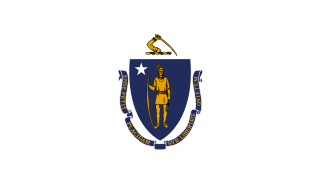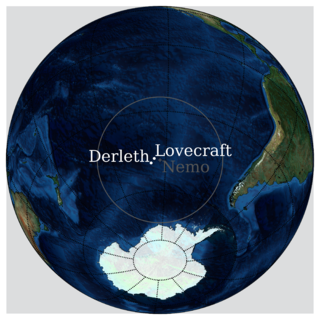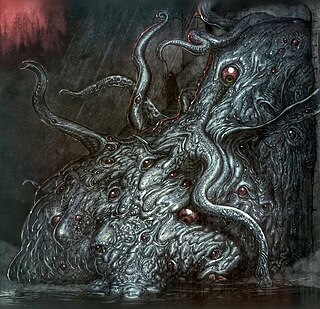It is proposed that this article be deleted because of the following concern:
If you can address this concern by improving, copyediting, sourcing, renaming, or merging the page, please edit this page and do so. You may remove this message if you improve the article or otherwise object to deletion for any reason. Although not required, you are encouraged to explain why you object to the deletion, either in your edit summary or on the talk page. If this template is removed, do not replace it . The article may be deleted if this message remains in place for seven days, i.e., after 02:34, 14 November 2019 (UTC). Find sources: "Miskatonic River" – news · newspapers · books · scholar · JSTOR |
The Miskatonic River is a fictional New England river in the writings of H. P. Lovecraft. It is also the name of a river system, the Miskatonic Valley. The equally fictitious Miskatonic University in Arkham is named after this river. The Miskatonic was first mentioned (as "Miskatonic Valley") in Lovecraft's "The Picture in the House" (1920).

New England is a region composed of six states in the northeastern United States: Maine, Vermont, New Hampshire, Massachusetts, Rhode Island, and Connecticut. It is bordered by the state of New York to the west and by the Canadian provinces of New Brunswick to the northeast and Quebec to the north. The Atlantic Ocean is to the east and southeast, and Long Island Sound is to the southwest. Boston is New England's largest city, as well as the capital of Massachusetts. Greater Boston is the largest metropolitan area, with nearly a third of New England's population; this area includes Worcester, Massachusetts, Manchester, New Hampshire, and Providence, Rhode Island.

Howard Phillips Lovecraft was an American writer of weird fiction and horror fiction. Born in Providence, Rhode Island, he spent most of his life there, and his fiction was primarily set against a New England backdrop. Lovecraft was never able to support himself from earnings as an author and editor, and he subsisted in progressively strained circumstances in his last years. He died of cancer at the age of 46.
Miskatonic University is a fictional university located in Arkham, a fictional town in Essex County, Massachusetts. It is named after the Miskatonic River. After first appearing in H. P. Lovecraft's 1922 story "Herbert West–Reanimator", the school appeared in numerous Cthulhu Mythos stories by Lovecraft and other writers. The story "The Dunwich Horror" implies that Miskatonic University is a highly prestigious university, on par with Harvard University, and that Harvard and Miskatonic are the two most popular schools for the children of the Massachusetts “Old Gentry”. The university also appears in role-playing games and board games based on the mythos.
The fictional communities of Arkham and Dunwich, Massachusetts, are said to be located along the Miskatonic. In "The Colour Out of Space" (1927), the narrator claims that there is a "small island in the Miskatonic where the devil held court beside a curious stone altar older than the Indians."
Dunwich is a fictional village that appeared in the H. P. Lovecraft novella "The Dunwich Horror" (1929). Dunwich is found in the Miskatonic River Valley of Massachusetts, part of the region sometimes called Lovecraft Country. The inhabitants are depicted as inbred, uneducated, and very superstitious, while the town itself is described as economically poor with many decrepit and abandoned buildings.

Massachusetts, officially known as the Commonwealth of Massachusetts, is the most populous state in the New England region of the northeastern United States. It borders on the Atlantic Ocean to the east, the states of Connecticut and Rhode Island to the south, New Hampshire and Vermont to the north, and New York to the west. The state is named after the Massachusett tribe, which once inhabited the east side of the area, and is one of the original thirteen states. The capital of Massachusetts is Boston, which is also the most populous city in New England. Over 80% of the population of Massachusetts lives in the Greater Boston metropolitan area, a region influential upon American history, academia, and industry. Originally dependent on agriculture, fishing and trade, Massachusetts was transformed into a manufacturing center during the Industrial Revolution. During the 20th century, Massachusetts's economy shifted from manufacturing to services. Modern Massachusetts is a global leader in biotechnology, engineering, higher education, finance, and maritime trade.
"The Colour Out of Space" is a science fiction/horror short story by American author H. P. Lovecraft, written in March 1927. In the tale, an unnamed narrator pieces together the story of an area known by the locals as the "blasted heath" in the wild hills west of the fictional town of Arkham, Massachusetts. The narrator discovers that many years ago a meteorite crashed there, poisoning every living being nearby; vegetation grows large but foul tasting, animals are driven mad and deformed into grotesque shapes, and the people go insane or die one by one.











